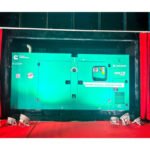The key to keeping buildings cool is what is known as passive daytime radiative cooling. If a surface reflects the sun’s rays and has a high thermal emittance — which maximizes radiation heat loss — the surface will lose heat to the surrounding atmosphere even in bright sunshine.
Until now, the best solution has been to paint the exterior surfaces of buildings white, but the pigments used to make white paint do not reflect all the wave lengths found in sunlight and can absorb UV radiation. The researchers at Columbia wanted to find a coating that works better.
What they came up with is a high performance polymer coating that can be applied like paint to any surface. The polymer forms a foam-like surface with lots of air pockets or voids. Those voids scatter and reflect sunlight, while the white color of the polymer resists solar heating.
This air void reflects all wavelengths of sunlight — from UV to infrared — for the white pigment typically used in paint. “This simple but fundamental modification yields exceptional reflectance and emittance that equal or surpass those of state-of-the-art PDRC (passive daytime radiative cooling) designs.
The researchers found that their coating lowered surface temperatures by 6º C in the hot, dry conditions of Arizona and 3º C in the foggy, tropical environment of Bangladesh.
This research has highlighted the importance of radiative cooling and represents an important breakthrough by demonstrating that hierarchically porous polymer coatings, which can be prepared cheaply and conveniently, give excellent cooling even in full sunlight.
Hope this will address the problem of “heat island” effect.
Reference- Cleantechnica, DNA India, Science Daily






